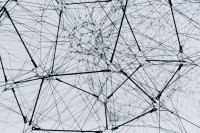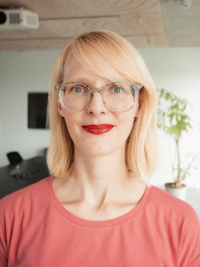Fairs: new paths beyond core business
by Emke Hillrichs

Anyone who thinks through alternative areas of opportunity in their business and revenue model in the event and trade show segment, who tries out ideas and consistently readjusts them, will find the right corridors for New Growth.
Think back to the 2020 NBA playoffs. These were held digitally, spectators were not allowed in the stadium because of Corona. Nevertheless, fans could be brought directly to the court - through the 'Together Mode' of Microsoft's communication platform. This uses AI-powered segmentation technology to bring people together in front of a virtual backdrop. For example, around 300 fans were projected onto five-meter-high LED displays on the perimeter of the game on three sides of the NBA basketball court. Fans were able to watch each other and simultaneously follow the game live. A prime example of successful event hybridization.
Advancing, differentiating and transforming business models.
Corona has hybridized our day-to-day operations in record time. There is now widespread acceptance of digital events. Behind digitization, however, is a much higher mission: it's about psychologically detaching from the physical venue and thus potentially expanding the target audience. Trade show visitors of the future today have two ways to participate in the event - through the physical or the digital trade show gate.
In order to find out which functions are suitable for hybridization, it is important to take a strategic look at your own offering and evaluate which components work digitally and which tend not to. It is often worthwhile to start by looking at knowledge offerings as well as inspiration and information offerings. From these, it is relatively easy to design learning and conference modules that offer added value for participants.
The hybridization of individual, suitable offerings from event and trade show brands as a first step in the transformation is also essential because it allows the core business to be continued in part in an additional digital form. After all, the investments in new business models also need to be financed.
Detachment from the time dimension
It is becoming apparent that in the future, trade shows and events will be bound neither by spatial nor temporal boundaries. Breaking away from the time dimension offers many advantages: When individual offerings are offered digitally, there are fewer reasons to limit an event to one weekend or one week a year. From this perspective, a trade show - or at least the digital components of it - can take place several times a year. Furthermore, target groups can be addressed more precisely by linking industry events to seasonal business focal points.
From single event to series
When it comes to serializing events and trade fairs, those responsible should focus precisely on the user benefit. It makes a big difference whether a networking or a passive experience is serialized. If a benefit is transformed first in the conception, the view for the revenue model and the go-to-market strategy is sharpened.
The Tomorrowland festival in 2020 is a good example of serialization. This is because it shows that revenue and business models hold promising opportunities for new growth, especially when digital opportunities are recognized and expanded in parallel with analog offerings. After the digital Tomorrowland, all the DJs' performances were made available on the Internet. An on-demand platform that allowed the festival to be experienced once again - or in other words: a Netflix for fans of electronic music. The interesting thing about this kind of serialization is that the temporal dimension is completely eliminated - users can access the DJ sets day and night - and the festival organizers have also created a second revenue stream.
Looking to the future
Having already thought about which parts of the offer are particularly suitable for transformation, trade fair and event organizers should identify their own competencies behind them and recompose them. In other words, dissect the real brand assets and reinterpret them - with new functions for new or old target groups.
It is important to determine what else could be done with the competencies of the organization or brand: Which business areas and offerings can the brand still offer as a true blue ocean strategy? Could one's own organization organize digital conferences in addition to physical ones in the future, i.e., impart knowledge? Then one should take a closer look at the market of professional media or adult education. And there's a lot happening here right now: from TED to the 'House of Beautiful Business' to the 'School of Life' - to name just a few examples.
A real wizard in terms of new business models and revenue streams is Amazon. Starting with e-commerce, the company now also offers cloud solutions with Amazon Web Sevices. Other companies can learn a thing or two from this. For example, how to have the courage to explore one's own potential and new avenues outside of the core business in accordance with one's own skills. The following questions can help: What is our organization good at? What would happen if our company had to discontinue its current offering from one day to the next? What new things can we do based on the strengths of our brand?
Through deconstruction to New Growth
To set out on the road to transformation, decision-makers must be prepared to move away from operational activities in their strategic thinking. Organizers must think ahead, differentiate and transform their business models. They need the courage to deconstruct themselves and the imagination to recombine previous competencies and offerings.
This is just as true in the trade show and event segment as it is in other industries. Particularly in complex industries, the broad and future-oriented positioning offers the possibility of multidimensional growth in the new offer ecosystem. However, this does not mean arbitrariness, but rather a system of mutually complementary business models - for a sustainable business orientation.
This article first appeared on 29.11.2021 in Trendreport.
We are happy to receive project inquiries



